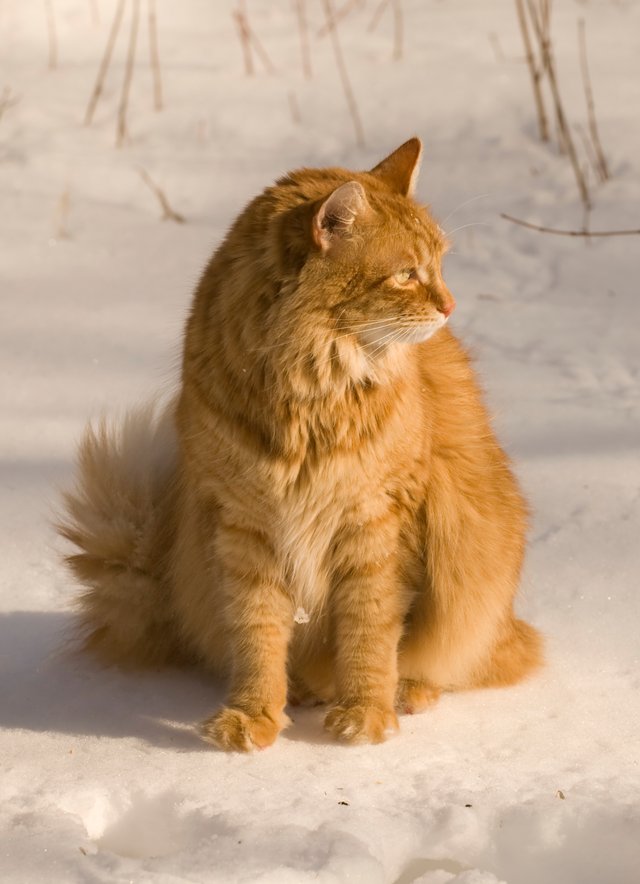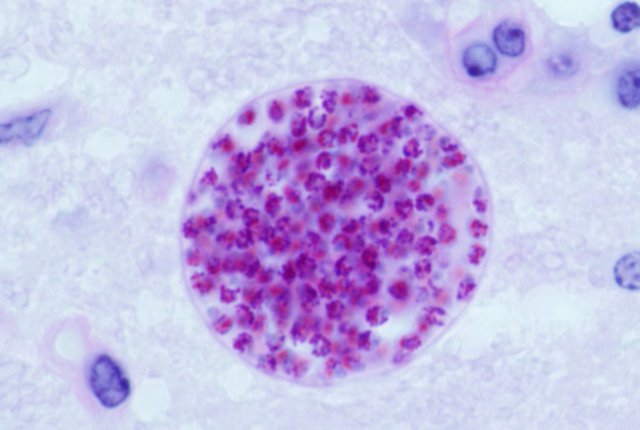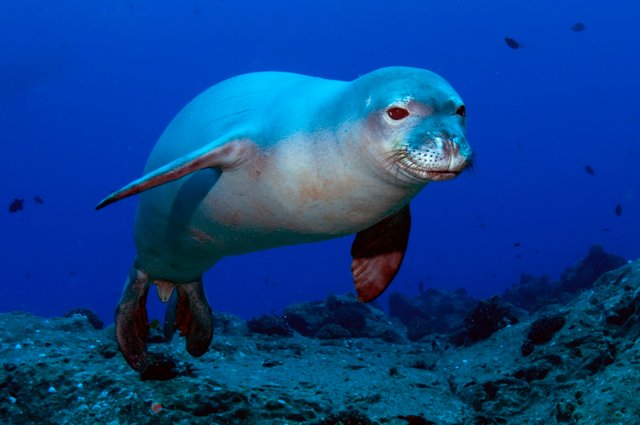Toxoplasmosis is the leading disease-caused death for the endangered Hawaiian Monks Seals (Neomonachus schauinslandi), showing how much damage cats can indirectly do to the wildlife
Both feral and domestic cats have time and time again shown themselves to be big troublemakers for the local ecosystems, and it’s not really that strange when you think about it for a second. They are well-functioning predators that have evolved to kill most things that are smaller than themselves, but in contrast to most other predators, they don’t have a low population density. This low population density of predators are one of the main things that prevent smaller animals from simply being hunted to extinction, and as you expect, cats are found in a very high density where there are a lot of humans.

Cats are for sure cute, but never forget that they are deadly killers to rodents, birds, amphibians and other animals. Image by Gillie hunting , posted with the Creative Commons Attribution 2.0 Generic license.
I wrote about a New Zealand legend last year, where the legend claims that a single cat killed all the Lyall’s wren (Traversia lyalli), a species that at the time only lived on a small island. The legend is partially true, but he did in fact get help by a few feral cats as well. The point still stands; the cats easily decimated the population until it became extinct!
Today’s post is going to be about a more silent killer from the cats, and we’re talking about the spread of the small protozoan parasite called Toxoplasma gondii, and how it can negatively affect other animal species.
If you’re interested in learning a bit of the biology behind the parasite, and find out more about it, then once again I will send you to a previously written post. It’s been 2 years since I wrote that post, so most of you have probably not seen it, but there’s really little point in repeating myself here, so go check it out.
A short summary of the T. gondii
The parasite will cause people to get infected by a disease known as toxoplasmosis, and the parasite itself needs a cat to reproduce, so it will try to get from the other animal to the cat. Once in the cat, the parasite will produce eggs that can lie dormant in the excrements of the cat until they end up in a warm-blooded animal.
Animals that are frequently exposed to cat excrements are the ones who typically get infected, so yes, cat owners obviously have a much higher chance of getting the disease compared to people who hate cats.

A T. gondii tissue cyst in a mouse brain. Image is Public Domain.
Most humans don’t really show any big signs of being infected by the disease, but some get things like schizophrenia, depression, increased risk of suicide or reduced psychomotor performance. This means that those who shown symptoms are very bothered by this disease, and as you might have already guessed, this disease could be what made the “Crazy Cat Lady” thing.
It’s not as grim as it sounds in reality though, and there are also studies that point towards the fact that it might not be responsible for schizophrenia, so this is a debated subject. Most people don’t even get symptoms, which make sense when you realize that most cat-owners are infected.
Rodents and other animals do however get a lot more serious infection, and their behavioral change is a lot more noticeable. The infected mice do for instance get unafraid of cats, which obviously means that they will get killed and eaten. This is exactly what the parasite wants, since it is now back in a cat body where it can reproduce.
I think that this should be enough that you guys understand kind of how the parasite functions, but read my previous post on the matter for a much more detailed explanation.
The Hawaiian monk seal might get into trouble because of toxoplasmosis
Let’s return to what this post is actually about; how the toxoplasmosis is creating problems for the Hawaiian monk seals (Neomonachus schauinslandi). We just need a quick look at the Hawaiian monk seal, and its biology first, and we’re good to go!
This seal is classified as endangered by the IUCN Red List, and it’s one of only two monk seals left in the wild. Like you can assume from the name, the seal is found close to the Hawaiian islands, and it is in fact one of only two mammals that is endemic to the islands (the other one is the Hawaiian hoary bat (Lasiurus cinereus semotus).

A Hawaiian monk seal. Photo by Kent Backman, posted with the Creative Commons Attribution-Share Alike 3.0 Unported license.
It was hunted close to extinction back in the nineteenth century when whalers and sealers killed them for both their meat, their oil, and their skin. This put the population at a very low level, but conservation efforts have brought them back up to about 1,400 individuals. This is not too low, but they are still reliant on conservation efforts to prevent extinction.
While it does receive a lot of conservation efforts, it’s also facing a lot of problems. It faces a lot of predation from sharks, as well as human-made threats such as marine debris entanglement. A lot of juveniles also apparently starve to death.
The seal might even be one of the endangered species with the lowest genetic diversity, which could be caused by several factors. The main one is that very few individuals survived the onslaught in the nineteenth century, while it has since got worse since only a few healthy individuals have been creating a lot more offspring than the average.
Seal puppies! Unfortunately the juvenile survival rate for this species is low, so they are in for a struggle to survive. Image is Public Domain.
How the toxoplasmosis infects the Hawaiian monk seals
Between May 15th and May 17th 2018, three dead monk seals were found on a beach on Oʻahu. NOAA took samples of them to figure out the cause of death, and their conclusion is that they died of toxoplasmosis that caused multiple organ dysfunction and failure. The dead seals had no indication of having died from any other source, so the agency is sure that they did in fact die as a consequence of toxoplasmosis.
This is not the first time that scientists have believed toxoplasmosis to be responsible for killing Hawaiian monk seals, and the total death toll is now 11. However, that is only counting cases where toxoplasmosis is confirmed to be responsible for their death!
It’s fairly safe to assume that a lot of seals have died from the organ failure when at sea, and the researchers are speculating that the total death toll could be a lot higher.
Even if we only count the 11 confirmed cases of mortality from the parasite, it is still the disease that is responsible for most death of the Hawaiian monk seals.
How do cats even interact with the Hawaiian monk seals?
It make sense when animals like small birds or rodents get infected with toxoplasmosis, because they might come into contact with cat excrements when they run about. However, it makes little sense that the monk seals are even anywhere close to cat poop, since cats don’t tend to like water, and the Hawaiian monk seals rarely get up from it.
The answer lies in the ability of the T. gondii eggs to survive in cat poo for a very long time. They are believed to be able to survive for an entire year while in their dormant state, and at this point the excrements have a long time to be washed out to sea where they can come into contact with the local seals. Some speculate that sewage has helped the spread of the parasite, which seems likely.
At this point the eggs can infect the monk seals, which leads to the death in at least some of them. I have been unable to find out if most of them are infected, and that only some of them get serious symptoms, or if only a few are infected, but the infected ones all die. No matter which of these are correct, the disease is obviously a big problem for a marine mammal species like this that is already facing lots of other threats to their survival!
It's actually very fascinating to see how much indirect trouble our little furry friends can create, and even their poop can kill other animals for an entire year after they shat it. I wonder what the next animal to have trouble because of domestic cat will be?
Sources
The CDC website about toxoplasmosis provided me with most of the sources for the information about the parasite, so head over there to learn more, or learn what to do if you think you are infected.
The information about toxoplasmosis in the Hawaiian monk seals is provided by NOAA Fisheries, the agency that was responsible for finding the cause of death in the dead monk seals.
Other sources are pretty much spread out in the text where they can be used to back one of my statements. Make sure to click on these if you are interested in learning even more about toxoplasmosis, or the Hawaiian monk seal.
Thanks for reading
This has been the longest biology post I have written in a while, so let me know what you think! And sorry about the current delay on answering comments; life’s a bit busy these summer days. And thanks for reading.
About @valth
Hey, I'm @valth - the author of this post. I love to write about nature, biology, animals, nature conservation, ecology and other related branches of science, and I occasionally write about my life, about Steem or about random stuff as well. I'm trying my best to write at least one post every day, so make sure to give me a follow if you enjoy my content and want to see more of it.
Join the @valth community!
I love nothing more than to engage with my readers, so please join the @valth community in the comment section. You will definitely find more information about the topic, personal experiences, questions, and even opposing views down there, so don't miss out on learning more.
I always reward users who post good comments, so please take the opportunity to share your views and get a small upvote in exchange for it.
I'm surprised most humans don't seem to care about this. I don't think I will ever own another cat because of this.
I know! Cats do so much damage to the local ecosystems, and pretty much all cat-owners are infected with toxoplasmosis. Those are pretty big drawbacks in my opinion.
Is it not possible that the harm cats do to humans is more than balanced by their ability to check the presence of rodents. Are rodents not a far graver risk to public health? Just a thought here....
That's a good question. It would certainly be very interesting to see a study that compares the benefits and negative aspects of having domestic cats. The problem is of course that the different benefits and costs are unmeasureable to each other. For example; how many less rodents are a species of birds worth?
That seems an unanswerable question...everybody loves birds. And yet, I find myself googling articles, because the obvious can be misleading...
Yeah, exactly. It was meant more as a rhetorical question than a real one.
It just sounds so surreal that the monk seals could die from toxoplasmosis. As you mentioned, toxoplasmosis is changing human behavior as well. For example men infected with toxoplasmosis is much more promiscuous and are rated as more attractive than non-infected controls. Interesting field actually. Worthy of some more research.
Yeah, it's definitely a bit surreal. And it's truly fascinating how a parasite like this one can alter the behavior of its host to such a degree.
No offence, although the cat poop is the carrier but improper sanitary conditions are main reason...So instead of blaming cats, perhaps we need a way to manage their poop in a way that is more efficient...
Managing cat poop sounds like a big hurdle unless you've got an indoor cat. I don't really think it's plausible to stop the cats from pooping outside and letting the waste reach the ocean and the seals.
Great post @valth. This is the best way to draw an attention towards ecology. I appreciate your work. Nice content.
Thanks for sharing this post.
Have a great day!
Thanks, I'm glad you liked the post ;)
I left your article impacted, because I never thought that the poop of the cat could harm other animals, even a water animal. Excellent work.
Thanks, I'm glad you learned something new from it! :D
Great post.
Posts that enlighten and increase knowledge. Reminds us to always take care of your health and not let them become carriers and causes of illness. Because as pets cat is very pampered and often make contact with the owner. he had a habit of approaching and asked to be stroked so as to enable the spread of the disease. Likewise the habit of poop cat in the sand that can bring harm to our children while playing in the sand.
Thanks, I'm glad to hear that you liked it :) And yes, you should take some precautions when interacting with cats, especially when handling their waste.
If it can effect our domestic cat then we should get her check up monthly.through this a serious cause of this disease can be prevented.I am shocked t kno about this harmful life taking disease.
The disease is not really a problem for the cats itself, it's a much bigger issue for the other organisms that get affected. So no need to take your cat for a checkup ;)
I really like cats, I often play with cats.
I just found out now, if the cat's body is a parasite.
I will be careful now. Is the parasite so dangerous?
It is interesting and useful article.
Thank you very much my friend.
Have a good day @valth
I'm glad you like the post. You don't really need to be careful about the cat itself, because the parasite can only affect other organisms from its excrement (poop), so be sure that you are hygienic when dealing with that. And yes, the disease can be dangerous, but it's not for most people.
oe, so we should not be exposed to cat and cat feces directly.
Cats are fine, cat poop is bad ;) It's not a problem to pet cats or stuff like that.
Very beautiful cat.. 🐈🐈🐈 upvote done sir..
Uhm, thanks I guess.